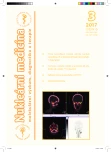Direct quantification of the growing activity of the mandible condyle in unilateral idiopathic condylar hyperplasia
Authors:
Gabriela Havlová 1; Jan Štembírek 2; Martin Havel 1,3; Michal Koláček 1,3; Otakar Kraft 1,3; Jiří Stránský 2
Authors‘ workplace:
Klinika nukleární medicíny
1; Klinika ústní, čelistní a obličejové chirurgie LF OU a FN Ostrava, ČR
2; Ústav zobrazovacích metod, Ostravská univerzita Ostrava, ČR
3
Published in:
NuklMed 2017;6:42-48
Category:
Original Article
Overview
Introduction:
Unilateral idiopathic condylar hyperplasia (UCH) is a condition that may cause malocclusion or facial asymmetry. Bone scintigraphy is important in planning of surgical treatment. It can assess the growing activity of the condyle. Conventional methodologies use the percentage difference between the activity of the two condyles or ratio of the condyle activity to a different bone reference area. We verified the possibility of absolute quantification of activity with the new Siemens xSPECT Quant technology.
Methods:
SPECT/CT examination of the head after 99mTc-HDP administration was performed in 21 patients (8 men, 13 women, mean age 31.7 ± 11.9 years) with condyle hyperplasia. SUV values (average – SUVavg and maximum –SUVmax) were obtained by modified iterative reconstruction OSCGM (Ordered Subset Conjugate Gradient Minimization). We compared the SUV values in the regions of interest over the two condyles with conventional assessement represented by counting the ratio of activities from the summated transaxial slices. Significant asymmetry was defined as a 55 % or higher condylar uptake.
Results:
The difference between the ratio of SUVavg and the ratio of counts from the conventional technique was not significant (p = 0.1907). The differences were found for SUVmax (p = 0.01417), where significant proportional and systematic error were evident. The decreasing tendency of SUVmax with increasing age was apparent. The SUVmax values did not differ condyles with asymetrically higher activity from those of the rest of the population (p = 0.9654, p = 0.1654 for a relatively less active condyle respectively).
Conclusions:
The evaluation of growth activity in UCH is important in planning the optimal treatment approach. The ratio of SUVavg values from the new xSPECT-Quant system corresponds to the conventional methodology of semi-quantitative comparison of osteoblastic activity on SPECT, unlike the ratio based on SUVmax values.
Key Words:
unilateral condylar hyperplasia, tomographic data quantification, xSPECT, SUV
Sources
1. Saridin CP, Raijmakers PG, Tuinzing DB et al. Bone scintigraphy as a diagnostic method in unilateral hyperactivity of the mandibular condyles: a review and meta-analysis of the literature. Int J Oral Maxillofac Surg 2011;40:11-17
2. Raijmakers PG, Karssemakers LH, Tuinzing DB. Female Predominance and Effect of Gender on Unilateral Condylar Hyperplasia: A Review and Meta-Analysis. J Oral Maxillofac Surg 2012; 70:e72–e76
3. Pirttiniemi PM. Associations of mandibular and facial asymmetries—A review. Am J Orthod Dentofacial Orthop 1994;106:191–200
4. Almeida LE, Zacharias J, Pierce S. Condylar hyperplasia: An updated review of the literature. Korean J Orthod 2015;45:333-340
5. Armstrong IS, Hoffmann SA.. Activity concentration measurements using a conjugate gradient (Siemens xSPECT) reconstruction algorithm in SPECT/CT. Nucl Med Commun 2016;37:1212–1217
6. Standardy zdravotní péče - „Národní radiologické standardy - nukleární medicína“. Soubor doporučení a návod pro tvorbu místních radiologických postupů (standardů) na diagnostických a terapeutických pracovištích nukleární medicíny v České republice. Věstník Ministerstva zdravotnictví České republiky;2016:203–364
7. Lassmann M, Treves ST. Paediatric radiopharmaceutical administration: harmonization of the 2007 EANM paediatric dosage card (version 1.5.2008) and the 2010 North American consensus guidelines. Eur J Nucl Med Mol Imaging 2014;41:1036–1041
8. Obwegeser HL, Makek MS. Hemimandibular hyperplasia--hemimandibular elongation. J Maxillofac Surg 1986;14:183–208
9. López B DF, Corral S CM. Comparison of planar bone scintigraphy and single photon emission computed tomography for diagnosis of active condylar hyperplasia. J Craniomaxillofac Surg 2016;44:70–74
10. Nitzan DW, Katsnelson A, Bermanis I et al. The Clinical Characteristics of Condylar Hyperplasia: Experience With 61 Patients. J Oral Maxillofac Surg 2008;66:312–318
11. Gnesin S, Ferreira PL, Malterre J et al. Phantom Validation of Tc-99m Absolute Quantification in a SPECT/CT Commercial Device. Comput Math Methods Med 2016;2016:4360371
12. Saridin CP, Raijmakers PG, Kloet RW et al. No Signs of Metabolic Hyperactivity in Patients With Unilateral Condylar Hyperactivity: An In Vivo Positron Emission Tomography Study. J Oral Maxillofac Surg 2009;67:576–581
13. Slootweg PJ, Müller H. Condylar hyperplasia. A clinico-pathological analysis of 22 cases. J Maxillofac Surg 1986;14:209–214
14. Eslami B, Behnia H, Javadi H et al. Histopathologic comparison of normal and hyperplastic condyles. Oral Surg Oral Med Oral Pathol Oral Radiol Endod 2003;96:711-717
15. Lippold C, Kruse-Losler B, Danesh G et al. Treatment of hemimandibular hyperplasia: The biological basis of condylectomy. Br J Oral Maxillofac Surg 2007;45:353–360
Labels
Nuclear medicine Radiodiagnostics RadiotherapyArticle was published in
Nuclear Medicine

2017 Issue 3
Most read in this issue
- Direct quantification of the growing activity of the mandible condyle in unilateral idiopathic condylar hyperplasia
- Radiation protection of PET/CT staff
- Comparison of staff irradiation after replacing 131I solution with capsules
